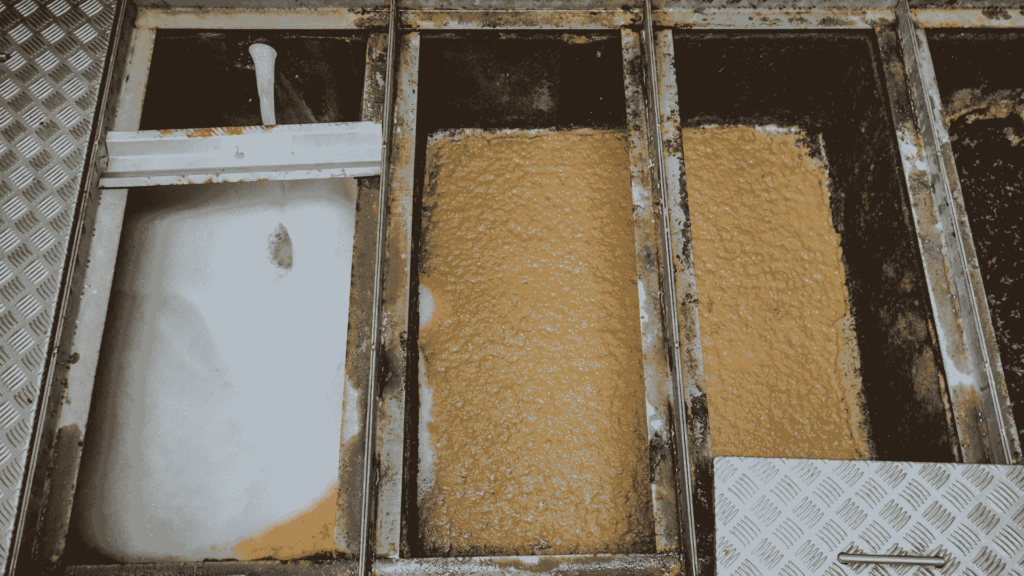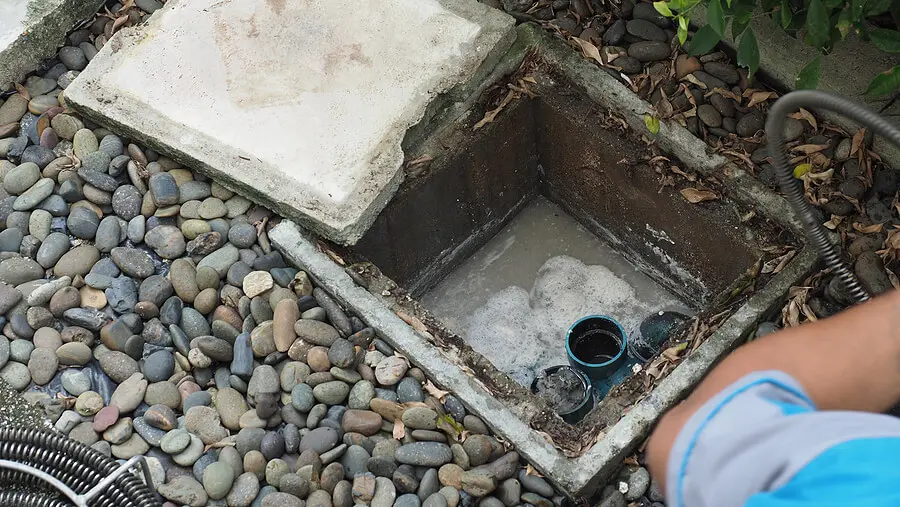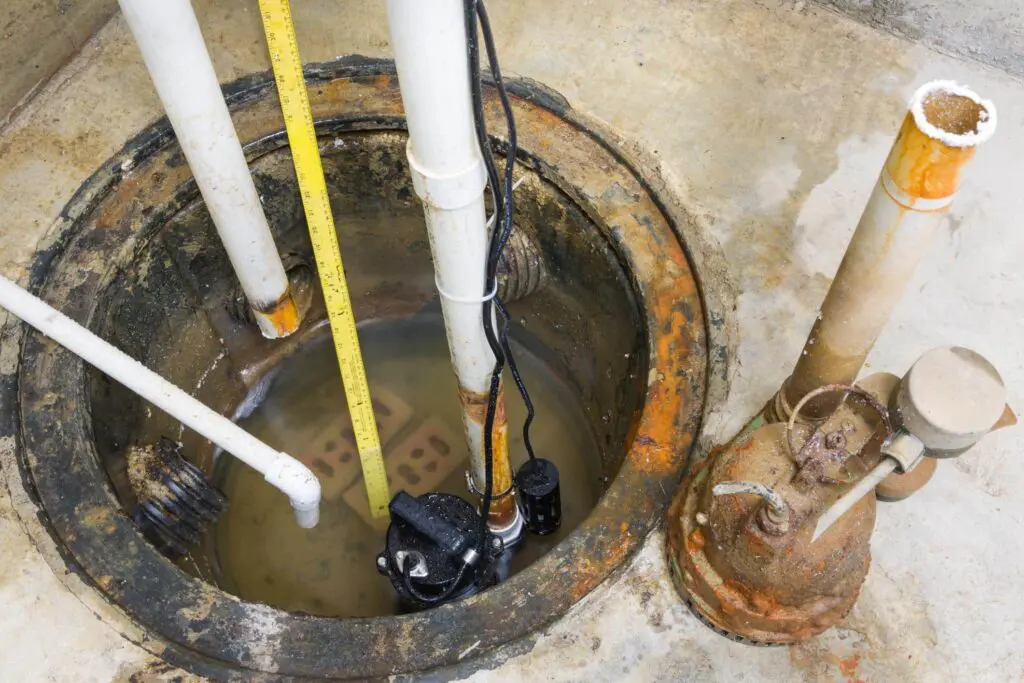What Size Grease Trap for 3 Compartment Sink | Sizing Guide
Picking the right grease trap for your 3-compartment sink is key to a smooth kitchen workflow. Go too small, and backups are inevitable. Go too big, and you’re wasting money.
In this guide, you’ll learn how to calculate the right size grease trap for your setup, avoid common mistakes, and stay code-compliant.
What Size Grease Trap for a 3 Compartment Sink?
Most 3-compartment sinks need a grease trap sized for 20–50 GPM or 40–100 pounds, depending on sink volume and flow rate.
Key Takeaways
- Grease traps prevent fats, oils, and grease from clogging drains.
- Sizing depends on sink volume, flow rate, and kitchen usage.
- Most 3-compartment sinks need a 20–50 GPM trap or 40–100 lbs.
- Always check local plumbing codes before installation.
- Oversizing can lead to inefficiency and higher cleaning costs.
What Is a Grease Trap and Why Do You Need One?

1. What is a grease trap?
Think of it like a bouncer for your plumbing. A grease trap catches fats, oils, and grease (aka FOG) before they slide down your pipes and start drama. It sits between your sink and the drain line, separating the gunk from the water.
2. Why you actually need one
If you’ve got a 3-compartment sink, you’re probably dishing out serious food volume. Without a grease trap, you’re flirting with clogs, backups, and costly plumber visits. Local codes usually require them too—so it’s not just a smart move, it’s a necessary one.
Bottom line? Grease traps keep your pipes flowing, your kitchen running, and your wallet chill.
Understanding a 3 Compartment Sink Setup
1. What’s the point of three sinks?
Each compartment has a job. One’s for washing, one’s for rinsing, and the last one’s for sanitizing. It’s the health code’s favorite setup.
2. Why it matters for grease traps
Three sinks mean lots of water—and a whole lot of grease if you’re handling food. That grease can clog drains fast if you don’t size the trap right.
3. Think flow, not just food
The more gallons per minute moving through your sinks, the bigger your grease trap needs to be. It’s less about what you’re cooking and more about how often you’re cleaning up.
How Grease Trap Size Is Calculated
1. Start with Sink Size and Flow Rate
First things first, measure each sink compartment. Width × Length × Depth gives you the volume in cubic inches.
Multiply that by three (for each compartment), then divide by 231 to convert it to gallons.
2. Factor in the Flow Rate
Now take that gallon number and consider how fast water flows in. If you’re using a dishwasher or pre-rinse station, bump up the estimate.
Faster flow = more grease and food bits hitting the trap at once.
3. Add a Safety Buffer
Grease traps aren’t just about size, they’re about staying ahead of the mess.
So take your base volume and multiply by 1.5 to give some breathing room. This keeps it from overflowing during heavy use.
4. The Final Cheat Code
If math’s not your vibe, here’s a quick tip: most 3 compartment sinks do well with a 20–50 gallon grease trap, depending on use.
But always double-check with your local code before locking it in. That’s your golden rule.
Recommended Grease Trap Size for a 3 Compartment Sink

Alright, let’s talk numbers—but keep it chill. For most standard 3-compartment sinks, you’re looking at a grease trap rated for 20 to 50 gallons per minute (GPM). That usually translates to a 40 to 100-pound grease trap.
Why? Because each sink basin dumps out some serious flow, especially during a rush. You don’t want greasy water backing up like last weekend’s group text.
Still unsure? The cheat code is this: total sink volume (in gallons) × 0.75 = minimum GPM. That gives you a safe starting point without overdoing it.
If you’ve got a high-traffic kitchen or wash heavy cookware, size up. It’s a flex that saves your plumbing from throwing tantrums later.
Bottom line—get the trap that keeps your flow clean and your kitchen stress-free. It’s not just about compliance, it’s about keeping things smooth behind the scenes.
Factors That Influence the Right Size Grease Trap
1. Sink Size and Flow Rate
Bigger sinks push more water—and grease—through the system. That means you’ll need a trap that can keep up without overflowing.
2. Number of Daily Washes
If your crew’s running dishes all day, you’re pumping more fats, oils, and grease (FOG) into the drain. More use? Go bigger on the trap.
3. Dish Type and Grease Load
Running a diner? Fried chicken joint? Grease traps in these spots need more power than a salad bar setup. It’s not just volume, it’s the kind of food too.
4. Local Plumbing Codes
Some cities have rules on trap sizing based on sink volume or flow rate. Check your area—no one wants a fine over FOG.
5. Space and Setup
Under-sink or outdoor? Your setup matters. If space is tight, you may need to get clever with sizing and layout to stay compliant and efficient.
Local Regulations and Compliance Considerations
1. Know Your Local Code
Not every city plays by the same rules. Some spots have strict grease trap sizing based on sink volume, daily water use, or flow rate.
2. Talk to Your Health Department
Before locking in a size, give your local health inspector or building department a call. They’ll usually tell you the minimum requirements straight up.
3. Avoid Fines, Stay Legit
Installing the wrong size? That’s an invite for citations or shutdowns. Better to ask now than get hit with a fine later. Grease traps aren’t just plumbing—they’re paperwork too.
Should You Oversize Your Grease Trap?

Going bigger sounds like a flex, but it’s not always the smart play. Oversizing your grease trap might seem like a “just in case” move, but it can backfire.
Too large, and grease cools too fast, solidifies, and clogs up the trap. Plus, cleaning a half-empty tank costs more and doesn’t do much for performance. That’s why scheduling regular grease trap maintenance in Miami is essential to ensure the system operates efficiently without unnecessary expenses or downtime.
If your 3-compartment sink has consistent use, size it based on real flow—not guesswork. Smart sizing keeps things efficient and your wallet chill.
Frequently Asked Questions
1. How do I size a grease trap for a 3 compartment sink?
Start with sink volume. Multiply length × width × depth (in inches), divide by 231 for gallons. Multiply by 2 to 2.5 for flow rate. That’s your rough trap size.
2. What’s the minimum size grease trap I should use?
Shoot for at least 20–30 gallons per minute. That’s usually the baseline for small commercial sinks. Anything smaller will fill up too fast and turn into a problem.
3. Do I need a certified plumber to install it?
Technically, maybe not. But should you? Definitely. A pro will make sure it meets local codes and doesn’t back up during a lunch rush.
4. How often do grease traps need cleaning?
Clean when 25% full—typically every 1–3 months. Delaying it can lead to clogs and fines.
Conclusion
Sizing a grease trap for your 3 compartment sink isn’t rocket science, but it does need a bit of math and common sense. Too small? You’ll be cleaning out clogs more than cooking. That’s where professional grease trap services in Aventura come in handy—ensuring your trap is the right size for your kitchen’s output and keeping everything flowing smoothly with regular maintenance and timely cleanouts.
Aim for a unit rated for at least 20–30 gallons per minute, depending on your sink size and flow rate. And always check your local codes—they’re not just for fun. When it comes to maintaining your grease trap, how to clean a grease trap under the sink is crucial to ensure it functions properly. Regular cleaning can help prevent clogs, odors, and plumbing issues. It’s typically done by removing the trap, emptying the collected grease, and cleaning it thoroughly with soap and water before reinstalling it.
Choose the right grease trap, install it correctly, and you’ll keep your kitchen running smoothly. It’s not exciting—but it’s essential to avoid backups and stay compliant.
